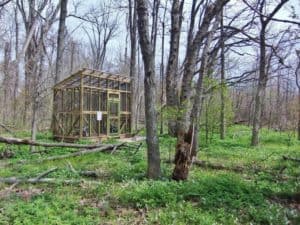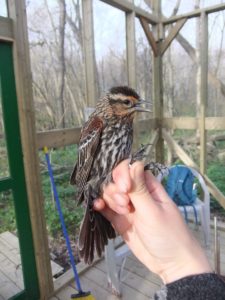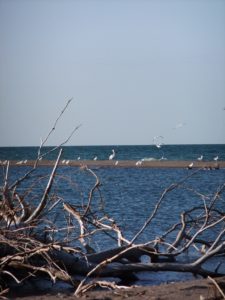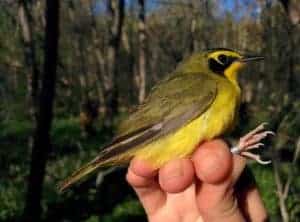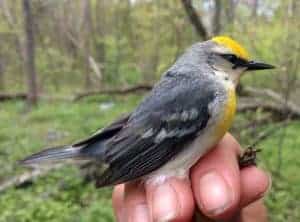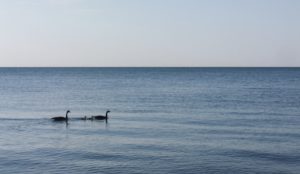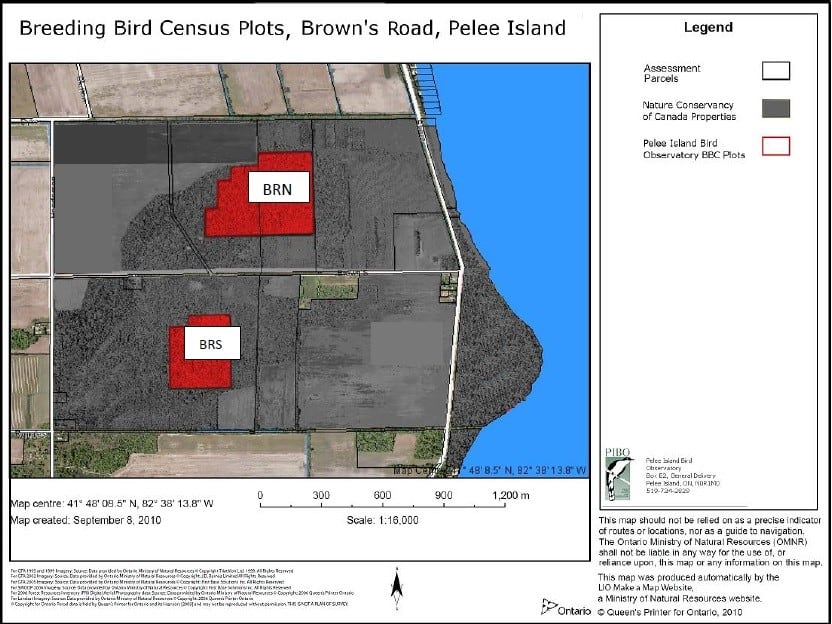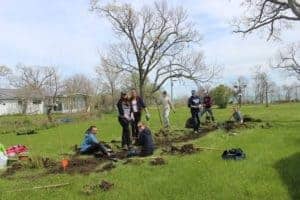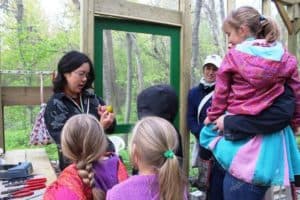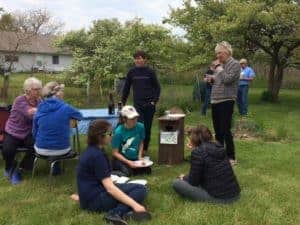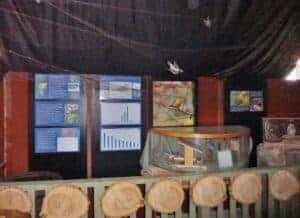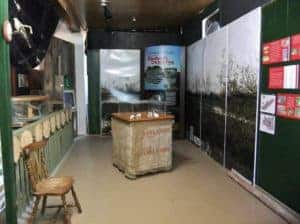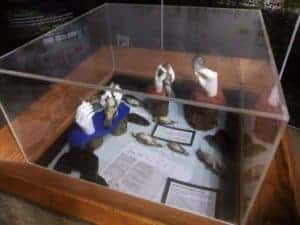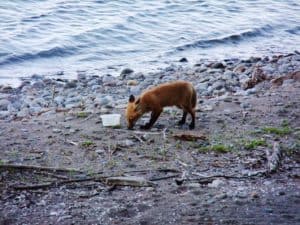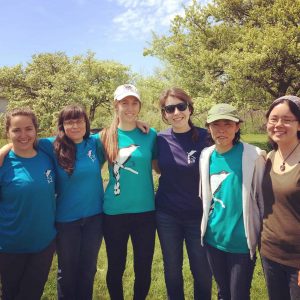Introduction
The Pelee Island Bird Observatory (PIBO)’s spring migration coverage at Fish Point Provincial Nature Reserve (Ontario Parks – Ontario Ministry of Natural Resources) ran from April 1st to June 11th, 2017, for a total of 72 coverage days. Five participants helped to record 163 species at Fish Point during PIBO’s standard count period. 659 birds of 61 species were banded over 1326.692 net-hours, for an average catch rate of 0.497 birds/net-hour.
| Table 1 – Migration Monitoring (Spring) | |||
| Observers | Sumiko Onishi, Sachi Schott, Alice Pintaric, Carolyn Zanchetta, Graeme C. Gibson | ||
| # of Coverage Days | 72 | ||
| Birds captured* | 659 | Species captured* | 61 |
| Net hours | 1326.692 | Birds/net hour | 0.497 |
| Notes | Two Kentucky Warblers banded; Brewster’s Warbler banded; Tree Swallow banded; Lark Sparrow observed; Shrike sp. observed. | ||
| *combines banding, retrap and capture data | |||
Banding station at Fish Point. Photo By Schi Schott
| Table 2 – Birds captured at Fish Point in spring 2017 | |||
| Species | Captured* | Species | Captured* |
| Ruby-throated Hummingbird | 8 | Magnolia Warbler | 20 |
| Downy Woodpecker | 2 | Cape May Warbler | 2 |
| Eastern Wood–pewee | 3 | Black-throated Blue Warbler | 12 |
| Yellow-bellied Flycatcher | 7 | Yellow-rumped Warbler | 19 |
| ‘Traill’s’ Flycatcher | 10 | Black-throated Green Warbler | 7 |
| Least Flycatcher | 1 | Bay-breasted Warbler | 1 |
| Red-eyed Vireo | 3 | Blackpoll Warbler | 3 |
| Blue-headed Vireo | 12 | Black-and-white Warbler | 9 |
| Blue Jay | 8 | American Redstart | 15 |
| Tree Swallow | 1 | Ovenbird | 55 |
| Black-capped Chickadee | 6 | Northern Waterthrush | 12 |
| Red-breasted Nuthatch | 4 | Kentucky Warbler | 2 |
| Carolina Wren | 2 | Connecticut Warbler | 1 |
| House Wren | 11 | Mourning Warbler | 6 |
| Golden-crowned Kinglet | 1 | Common Yellowthroat | 16 |
| Ruby-crowned Kinglet | 21 | Wilson’s Warbler | 4 |
| American Robin | 9 | Canada Warbler | 17 |
| Wood Thrush | 11 | Hooded Warbler | 1 |
| Veery | 13 | Northern Cardinal | 3 |
| Swainson’s Thrush | 31 | Rose-breasted Grosbeak | 2 |
| Gray-cheeked Thrush | 4 | Indigo Bunting | 10 |
| Hermit Thrush | 14 | White-throated Sparrow | 23 |
| Gray Catbird | 19 | Lincoln’s Sparrow | 5 |
| Brown Thrasher | 1 | Swamp Sparrow | 3 |
| Northern Parula | 1 | Brown-headed Cowbird | 10 |
| Orange-crowned Warbler | 1 | Red-winged Blackbird | 46 |
| Tennessee Warbler | 7 | Common Grackle | 16 |
| Blue-winged Warbler | 4 | Baltimore Oriole | 14 |
| Golden-winged Warbler | American Goldfinch | 5 | |
| Brewster’s Warbler | 1 | Total captured | 659 |
| Nashville Warbler | 10 | Species & forms | 61 |
| Yellow Warbler | 80 | Net hrs. | 1326.692 |
| Chestnut-sided Warbler | 3 | Birds/net-hour | 0.497 |
| *includes birds banded, recaptured, and captured and released without being banded | |||
Spring Migration Summary
The Pelee Island Bird Observatory (PIBO) began its migration monitoring program on April 1st, 2017. The morning was cool and overcast, and notable mainly for the large number of waterfowl in Fox Pond: 60 birds were seen of 10 species, including Canada Geese, Wood Ducks, Buffleheads, Common Goldeneye, Northern Shovelers and two American Coots. Red-Winged Blackbirds and Common Grackles were very much in evidence, especially around Fox Pond, and their rasping, creaking calls could be heard all along Fish Point. American Robins and Northern Cardinals were also common.
Stormy weather and strong north-west winds on April 6th and 7th led to fewer songbird sightings, though the Tree Swallows appeared to be invigorated by the high winds and were seen in large numbers flying over the lake. Bonaparte’s Gulls were also very active. The ducks stuck mostly to Fox Pond, where the waters were calm, and a Ruddy Duck and Ring-Necked Duck seen on April 6th were new for the season.
More songbirds appeared as the weather calmed down and temperatures increased. The first Myrtle Warblers and Ruby-Crowned Kinglets were seen on April 8th, along with the first Belted Kingfisher, which was fishing in Fox Pond. Slate-Coloured Juncos were frequently seen in flocks feeding along the beach, occasionally accompanied by Swamp Sparrows, Field Sparrows, American Tree Sparrows and Chipping Sparrows. The warmer weather also caused the local insects to become more active, to the benefit of the birds: a small flock of Golden-Crowned Kinglets was observed feeding on a hatch of midges at the edge of Fox Pond, and the numbers of Tree Sparrows seen flying over the trees increased. The ducks took advantage of the gentler winds to move out onto the lake – hundreds of Red-Breasted Mergansers were counted swimming and flying over the lake on the 10th, and a large raft of Scaup species had assembled off the east side of the tip on April 11th.
The first notable sighting of the year was of a shrike that was seen on census on April 13th at the end of Fish Point. Unfortunately it was a very wary bird and remained at a distance, making it difficult to say for certain if it was a Northern Shrike or a Loggerhead Shrike, but the balance of probability seemed to indicate that it was a Loggerhead. The field markings that were visible (a wide eye band and the absence of a white eye ring) were typical of a Loggerhead, and as Northern Shrikes migrate much earlier, they would typically have already passed through southern Ontario by the end of March. PIBO staff returned later in the day to try and get a closer look at the bird, but it had moved on.
Very few raptor species were seen in the first few weeks of May: Bald Eagles have been seen the most consistently, and Cooper’s Hawks had been observed on a couple different occasions as well. A Merlin flew over Fish Point on April 5th. On most afternoons, large kettles of migrating Turkey Vultures could be seen riding the thermals over the island, often accompanied by Red-Tailed Hawks. A Broad-Winged Hawk was observed by two visiting Bird Studies Canada employees. Overall, species counts remained fairly consistent over the first two weeks of the migration season, with between 31 and 40 species being seen each morning.
As the month progressed, the weather grew warmer and new greenery began to appear. Many trees around the netting area began to bud and a few leaves were already beginning to show themselves. Fox Pond became crowded with water lilies, leaving little room for ducks. Instead, the open waters of the lake provided a stage for the mating displays of the Red-Breasted Mergansers who formed flotillas off the beach. Almost every day brought an addition or two to the list of species observed by PIBO in 2017. A Spotted Sandpiper that was seen on the west beach of Fish Point on April 19th was the first shorebird recorded this spring. Sanderling, Sora and Black-Bellied Plovers arrived on April 28th, but the overall shorebird numbers remained low. The south winds on April 27th brought in a total of thirteen species that were new for the season, including such colourful characters as Baltimore Orioles, Scarlet Tanagers and Rose-Breasted Grosbeaks.
The nesting efforts being made by some early-breeding birds continued apace: a female American Robin was already sitting on a nest in the trees by Fox Pond by the end of May, and the European Starlings, Red-Winged Blackbirds and others were seen carrying nesting material. A precocious family of Canada Geese was seen stepping cautiously along the beach at Fish Point on April 23rd, and at least one pair of Canada Geese began sitting on their nest in Fox Pond.
After dealing with some unanticipated net repairs, all ten of PIBO’s mist nets were set up and ready to go by the 19th, but banding was postponed when the thunderstorms and scudding rain marred the morning of May 20th. The unsettled weather did have the effect of blowing some new species onto the island, including the first Eastern Bluebird of the year. Banding began in earnest on April 22nd. The numbers of birds banded each morning was low, and generally included some combination of Blue Jays, Red-Winged Blackbirds, Hermit Thrushes and Downy Woodpeckers.
Female Red-winged Blackbird. Photo by Sachi Schott.
From April 22nd onwards, new warbler species began trickling through Fish Point. The first Western Palm Warblers, Nashville Warblers, Black-and-White Warblers, and Yellow Warblers were seen and heard around Fish Point, the first salvos in what would soon become a full chorus of warbler species. And on April 30th, the banding operations were given a shot of colour by the capture of the first Cape May, Black-Throated Green and Myrtle Warblers of the season, all of them males.
On April 23rd, a Sandhill Crane flew over the netting area, calling sonorously as it went, and a Grasshopper Sparrow was seen on census on April 26th. And on April 29th the first American White Pelicans of the year were spotted out on the tip of Fish Point, standing out amid the much smaller gulls and terns as they preened. Three more were seen on census the following day, the first of many that would be seen in the spring to come.
American White Pelican. Photo by Sachi Schott.
The overcast and unsettled weather from the end of April continued into the beginning of May, severely curtailing PIBO’s mist netting efforts. The wind, meanwhile, seemed to come from every direction but south, creating challenging conditions for migratory songbirds. The arrival of warbler species such as the Magnolia and Chestnut-Sided Warbler seemed to be delayed compared to previous years, and other species appeared to linger on the island for longer than they would normally. For example, it was assumed that the Golden-Crowned Kinglets had all moved north to their breeding grounds, but one was banded on May 6th and others were sighted periodically right up until May 8th. The unsettled weather may also have been responsible for bringing in the two Kentucky Warblers PIBO banded this spring, one on May 7th and the second on May 10th.
With the low numbers of warbler species being seen during our official count period, it seemed that the birders visiting Pelee Island for the Spring Song weekend would be disappointed: but, during the preceding week, the skies cleared, the mornings grew warmer, and birds appeared in abundance! Despite a late start, 72 birds were banded on May 11th, the busiest banding day to date. It was also the day that PIBO banded a Brewster’s Warbler, an unusual species for the island. 73 species were observed as part of PIBO’s migration monitoring, compared to 65 the day before – an auspicious increase that made Sumiko Onishi, PIBO’s Field Supervisor, decide to begin her Birdathon that morning. She ended her 24-hour birding marathon at 7:20 a.m. on May 12th – just in time for her to go on the daily census! – and saw a total of 98 species.
Large flocks of Blue Jays were seen frequently from May 9th to May 18th. They were an unusual sight – fall, not spring, is usually the time of year when jays gather together in large groups – and eventually their numbers dropped back down to the more usual ones and twos. On May 17th the most numerous species of bird was the Cedar Waxwing, with over a hundred seen on census and in the netting area, flying by in flocks of thirty to forty birds at a time. Again, this push of birds lasted for a few days and then tapered off down to more sporadic sightings.
Steady south winds from May 16th to 18th brought more warbler species into the area, including Bay-Breasted Warblers, Blackpoll Warblers, the first Mourning Warbler of the spring and the first Hooded Warbler banded this season, increasing the daily species totals. The weather changed abruptly on the 19th when the wind shifted to the north and the temperature plunged down to 11 degrees Celsius from 21 degrees Celsius the day before. The number of bird species remained high though, possibly because the change in the wind direction discouraged them from migrating. 18 species of warbler were observed, but in small numbers. Many flycatcher species were around, including Eastern Kingbirds, Eastern Wood-Pewees and a Willow Flycatcher, identified by its distinctive call. On May 20th, the overcast skies and strong winds seemed to force the birds to stay down low in the trees, at a good height to be caught in the mist nets. 51 birds were banded of 24 species, the most numerous of which was the Swainson’s Thrush. American Redstarts were also common.
Shorebird species appeared periodically on census, with Black-bellied Plovers and Spotted Sandpipers putting in an occasional appearance. The first Ruddy Turnstone of the season was seen on May 21st, and three Red Knots were out foraging at the end of the tip on May 26th, looking very small amid all the Herring Gulls. Outside of the standard migration monitoring efforts, PIBO’s summer volunteer Alice Pintaric went birding at Fish Point on May 17th and saw many shorebirds, including forty Black-bellied Plovers and ten Whimbrels, as well as Ruddy Turnstones, Dunlin and Short-billed Dowitchers.
The warm temperatures on May 23rd had the unpleasant side-effect of spurring the development of the many mosquitoes that typically inhabit Fish Point. They enjoyed feeding on PIBO staff while being fed on in turn by some of the birds in the area – two Common Grackles in particular were observed eating the insects out of some spider webs high up in a dead tree. The season’s first Connecticut Warbler was banded on the 23rd and was still singing in the area on May 24th.
Overcast skies and rainy weather rolled in on May 24th, curtailing PIBO’s mist-netting efforts. On census, a Least Bittern was heard calling in Fox Pond. It was absent on the 25th, which was also rainy, but was heard again on the 27th.
In the netting area, each morning’s bird banding grew quieter and quieter, until a nadir was reached of zero birds banded on May 30th! It was a sign that it was time to close up the nets for the spring. PIBO’s last day of banding was on May 31st.
In spite of the lack of migrants, though, the spring still had a few surprises in store for PIBO. The census continued from June 1st to 11th. A few migrants were seen at the beginning of the month, including a Veery that was heard singing on June 6th and a few small flocks of Least Sandpipers and Sanderlings. One last unusual bird turned up as well – on June 3rd, a Lark Sparrow was seen by the west beach. This striking sparrow is a frequent vagrant in Ontario, with five or six showing up each year. As well, an Acadian Flycatcher was heard singing at the beginning of the trail on June 3rd.
From June 7th onwards almost all the birds that were seen and heard were birds on their breeding territories. Many Red-winged Blackbird nests, made of woven grasses, could be seen in among the phragmites at the edges of Fox Pond, and the adult birds were busy ferrying beaks full of fish flies, gleaned from the trees nearby, back to their hungry nestlings.
At least one pair of Canada Geese nested in Fox Pond this year. Other family groups, and groups of unpaired adults, were seen on the beaches and at the tip of the point. One large blended family was seen paddling in Mosquito Bay on June 11th. The pair of adults in question were escorting a total of twenty-two goslings, of various sizes.
Double-crested Cormorants, Great Blue Herons, Herring Gulls, Ring-billed Gulls, Great Black-backed Gulls, and American White Pelicans were also seen almost daily. The number of American White Pelicans reached a peak on June 10th, when 30 were counted out at the tip. Seen in a large group, it became easy to see the plumage and colour variations of individual birds. Young white pelicans have black on their heads, and pale bills; older birds have more white, and their bills are more strongly coloured. As well, white pelicans in breeding condition develop a ‘centerboard’ that rises up from the top of their bill. Presumably, other white pelicans find this very attractive!
In total, PIBO’s spring migration coverage at Fish Point ran from April 1st to June 11th, 2017, for a total of 72 coverage days. Five participants helped to record 163 species at Fish Point during PIBO’s standard count period. 659 birds of 61 species were banded over 1326.692 net-hours, for an average catch rate of 0.497 birds/net-hour.
Notable band encounters
A female Brown-headed Cowbird recaptured on May 18th was found to have been originally banded at PIBO by Sumiko Onishi on the 13th of April, 2011. The bird was originally aged as After Hatch Year, making it at least seven years old. It was captured again on May 20th. Several banded cowbirds were observed in the netting area this spring, and probably represented returns from previous years.
Kentucky Warbler. Photo by Alice Pintaric.
PIBO banded two Kentucky Warblers in the spring of 2017, the first on May 7th and the second on May 10th. These were the fifth and six Kentucky Warblers banded by PIBO in its fifteen years of operations. A Kentucky Warbler was also seen by Eric and Mike Oroz during the Spring Song Bird Race (May 12th to 13th) – possibly one of the ones we had banded!
Like the Ovenbird, which it is similar to in size and body shape, the Kentucky Warbler is a secretive ground-forager, more often heard than seen. On its wintering grounds in the tropics it sometimes accompanies swarms of army ants and feeds off the insects fleeing the swarm. It is an uncommon breeder in Ohio, Michigan and Pennsylvania, and is more common in the deep Carolinian forest to the south, in states like Kentucky and Tennessee. As a bird that lives in mature forests, the Kentucky Warbler is vulnerable to forest fragmentation as land is cleared for agricultural purposes. There are no Ontario breeding records for this bird to date, although a few who have overshot their breeding grounds are seen in southern Ontario every spring.
| Table 3 – Kentucky Warblers banded at PIBO 2003-2017 | ||||
| DATE | SEX | AGE | BANDER | NOTES |
| 10 May 2006 | Male | ASY | SNL | |
| 14 May 2006 | Male | SY | RFH | |
| 31 August 2007 | Male | HY | RD | Retrapped on 1 Sept 2007 |
| 15 May 2009 | Female | SY | AP | |
| 7 May 2017 | Male | UNK | SS | |
| 10 May 2017 | Female | SY | ALP | |
Brewster’s Warbler. Photo by Alice Pintaric.
A Brewster’s Warbler was observed by PIBO staff in the netting area on May 11th, 2017, and was captured and banded later that morning. This is the second Brewster’s Warbler to be banded by PIBO.
‘Brewster’s Warbler’ is the name given to the hybrids created by a cross between a Golden-Winged and a Blue-Winged Warbler. It has the black eye stripe and white wing bars of a Blue-Winged Warbler combined with the blue-grey back of a Golden-Winged Warbler, and a variable amount of yellow on the chest. These hybrids have become more common as the range of the Blue-Winged Warbler has expande and overlapped with the range of the less common, more geographically restricted Golden-Winged Warbler. Both of the parent species are uncommon migrants in southern Ontario during the first few weeks of May, and a few Brewster’s Warblers are seen at Point Pelee every spring.
PRAIRIE WARBLER
A Prairie Warbler was seen by Richard Pope on May 12th, 2017. This species is a migrant that is rarely seen in and around Point Pelee. Although its common name would seem to suggest that it prefers grassland habitats, it is actually named for the area where the ornithologist Alexander Wilson first found the species, near Bowling Green Kentucky, in ‘prairie country’. The Prairie Warbler itself prefers shrubby habitats in which to build its nests, including Christmas tree stands. Southern Ontario represents the northern limit of its breeding range.
KIRTLAND’S WARBLER
By far the most exciting bird sighting to come out of the 2017 Spring Song weekend was the Kirtland’s Warbler that was found by Peter Coo and Dawn Miles at Sheridan Point at the south end of the island.
The most significant breeding population of Kirtland’s Warblers is in central Michigan. In Ontario, nests and singing males have been occasionally reported around the Bruce Peninsula and Petawawa, in areas of Jack Pines.
SHRIKE SP.
A shrike was seen on census on April 13th at the end of Fish Point. It is difficult to say for certain if it was a Northern Shrike or a Loggerhead Shrike, but the balance of probability seems to indicate that it was a Loggerhead. For more information, please see the Spring Migration Summary.
GRASSHOPPER SPARROW
A Grasshopper Sparrow was seen on census by Sumiko Onishi on April 26th.
LARK SPARROW
Sumiko Onishi observed a Lark Sparrow at Fish Point while on census on June 3rd. It stood out because no sparrow species had been observed on census for over a week, and upon closer examination she was able to discern the black spot on its breast and the dark moustachial stripe that marked it as a Lark Sparrow.
Species at Risk
The following are notes on some of the birds observed by PIBO in 2017 that are endangered, threatened, or of special concern.
Prothonotary Warbler (Endangered) A male Prothonotary Warbler was heard singing near the nest boxes at Fish Point on June 24th and 26th. Considering the late date and the fact that it was not heard or seen with any frequency, it is likely that this was an unattached male, and that no Prothonotary Warblers nested on Pelee Island this year.
Yellow-breasted Chat (Endangered) A male Yellow-breasted Chat was heard singing at the Kestrel Stanley property (Nature Conservancy of Canada) on East-West Road on June 16th. It was not seen or heard again, and it is probable that no Yellow-breasted Chats nested on Pelee Island this year.
Acadian Flycatcher (Endangered ) An Acadian Flycatcher was heard singing at the head of the Fish Point trail on census June 3rd
Least Bittern (Threatened) A Least Bittern was heard in Lake Henry during the first Marsh Bird Survey on June 1st, and one was seen and heard during the third Marsh Bird Survey on July 5th. For more information, please see: Marsh Monitoring Program – Marsh Bird Surveys.
Bald Eagle PIBO has received second-hand reports of at least three Bald Eagle nests on Pelee Island in 2017. The birds themselves were frequently seen on census and elsewhere on the island.
Red-headed Woodpecker (Special Concern) Red-headed Woodpeckers were observed frequently in the netting area at Fish Point and on census, especially in the early part of the spring. They were also seen almost daily along the South Shore Road, especially around Dick’s Marina.
American White Pelican (Threatened) American White Pelicans have continued to be a fixture on and around Pelee Island in 2017. PIBO’s first sightings of them took place on April 29th, and since then they have been seen frequently at the tip of Fish Point and flying over the island. A flock of thirty pelicans was seen on Fish Point on June 10th.
| Table 4 – Species at Risk | |||
| Observers | Sumiko Onishi, Alice Pintaric, Sachi Schott, Graeme C. Gibson | Hours* | 14.5 |
| Notes | No evidence of Prothonotary Warblers or Yellow-breasted Chats breeding on Pelee Island in 2017 | ||
| *refers to time spent searching for SAR only – does not include Marsh Monitoring Program, daily census, or migration monitoring | |||
Breeding Birds at Fish Point
While no formal breeding bird census was conducted at Fish Point, the daily census that is conducted as part of the migration monitoring program provides an opportunity to determine which species have territories on the point. This year, observations of singing males and young-of-the-year indicate that the following species are breeding or have attempted to breed on Fish Point:
Canada Goose
Eastern Wood Pewee
Great Crested Flycatcher
Eastern Kingbird
Red-eyed Vireo
Tree Swallow
Carolina Wren
House Wren
Blue-gray Gnatcatcher
American Robin
Yellow Warbler
Northern Cardinal
Indigo Bunting
Red-winged Blackbird
Common Grackle
Baltimore Oriole
Interestingly, one male Carolina Wren with a territory at the head of the Fish Point trail is banded, and may be one of PIBO’s past visitors.
In the netting area, Red-Bellied Woodpeckers, American Robins and Tree Swallows were seen engaging in mating behaviour. A family group of three Tree Swallows contested with a pair of Downy Woodpeckers over possession of a nest cavity for several weeks: by the end of the banding season, the Tree Swallows appeared to have been victorious.
Family of Canada Geese. Photo by Sachi Schott.
Breeding Bird Census
The Breeding Bird Census (BBC) is a habitat-based survey that collects data that is used to determine the number of males holding territories within a given study plot. By surveying the same plots repeatedly over a number of years, researchers can measure changes in the diversity, distribution and abundance of breeding birds[1]. There are ten BBC plots on Pelee Island covering a range of habitats. The first round of surveys was completed in 2010, and PIBO began the second round of surveys in 2014.
Methods
In 2017, surveys were completed at Brown’s Road North (Florian Diamante Conservation Area – Nature Conservancy of Canada) and Brown’s Road South (Florian Diamante Conservation Area – Nature Conservancy of Canada). Each plot was visited ten times from 27 May to 27 June for between 1.5 to 4 hours. Eight of the visits took place in the morning, beginning one half-hour before sunrise, and two took place in the evening. The evening surveys were timed to end one half-hour before sunset. All bird activity was noted and data for each species was transferred onto individual maps to allow for the definition of territorial boundaries.
[1] Gibson, Graeme C., Breeding Bird Surveys on Pelee Island: 2009-2011. Pelee Island Bird Observatory. An unpublished report for the USFW Neotropical Migratory Bird Conservation Act Program. 72 pp. (including appendices). 2011.
Figure 1 – Map showing the location of Breeding Bird Census Plots on Brown’s Road, Pelee Island, Ontario. BBC01 (Brown’s Road North) is designated ‘BRN’; BBC02 (Brown’s Road South) is designated ‘BRS’.
Results
In total 72.5 hours were devoted to BBCs this year and 211 territories were documented belonging to 29 species.
| Table 5 – BROWN’S ROAD NORTH | BBC01 | |
| Landowner: Nature Conservancy of Canada | ||
| Location: Brown’s Road | ||
| Continuity: Last surveyed in 2010 | ||
| Habitat description: Alvar woodland; hackberry, white ash, blue ash, chinquapin oak, hawthorn, red oak, sugar maple; canopy 76%, 13-17 m high | ||
| Size: 13.75 ha | ||
| Year: 2017 | ||
| Weather: Mean start temperature 19.9 degrees Celcius | ||
| Coverage: 37.75 hours over 10 visits | ||
| Dates: 27 and 31 May, 03, 08, 10, 12, 15, 17, 22 and 27 June | ||
| Territories | ||
| Species | 2017 | 2010 |
| Red-winged Blackbird | 22 | 8 |
| House Wren* | 12 | 6 |
| Yellow Warbler | 8 | 3.5 |
| Indigo Bunting | 5 | 5 |
| Red-eyed Vireo | 4 | 1 |
| Eastern Wood-pewee | 3 | 4 |
| Eastern Towhee | 3 | 3 |
| Great Crested Flycatcher* | 3 | 2 |
| Northern Cardinal | 2 | 6 |
| Common Grackle | 2 | 5 |
| Baltimore Oriole | 2 | 1 |
| American Robin | 2 | 3 |
| Black-capped Chickadee | 1.5 | 2 |
| Gray Catbird | 1.5 | 2 |
| American Woodcock | 1 | |
| Blue Jay | 1 | 3 |
| Blue-gray Gnatcatcher | 1 | 1 |
| Brown-headed Cowbird | 1 | 1 |
| Tree Swallow | 1 | |
| Wild Turkey* | 1 | 1 |
| Downy Woodpecker | 0.5 | 5 |
| Red-bellied Woodpecker | 0.5 | |
| Yellow-billed Cuckoo | 0.5 | 2 |
| Yellow-shafted Flicker | 0.5 | |
| Cedar Waxwing | 1 | |
| Mourning Dove | 1 | |
| Scarlet Tanager | 1 | |
| Territories: | 79 | 67.5 |
| Per 40 hectares: | 229.82 | 196 |
| Species: | 24 | 23 |
| *Adult birds observed with young | ||
| Table 6 – BROWN’S ROAD SOUTH | BBC02 | |
| Landowner: Nature Conservancy of Canada | ||
| Location: Brown’s Road | ||
| Continuity: Last surveyed in 2010 | ||
| Habitat description: Alvar savannah/shrub thicket; hackberry, black walnut, chinquapin oak, white ash, red ash, hawthorn, red cedar, blue ash; canopy 53%, 8-12 m high | ||
| Size: 10 ha | ||
| Year: 2017 | ||
| Weather: Mean start temperature 20.6 degrees Celcius | ||
| Coverage: 34.75 hours over 10 visits | ||
| Dates: 27 and 30 May, 02, 05, 08, 11, 13, 15, 17, 21 June | ||
| Territories | ||
| Species | 2017 | 2010 |
| Red-winged Blackbird | 33.5 | 29.5 |
| Yellow Warbler | 32 | 11 |
| Eastern Towhee | 6 | 3 |
| Northern Cardinal | 5.5 | 6 |
| Tree Swallow | 5 | |
| Indigo Bunting | 5 | 3 |
| Mourning Dove | 4.5 | 6 |
| Brown-headed Cowbird | 4 | 7 |
| Field Sparrow | 4 | 6 |
| American Robin | 4 | 3 |
| Common Grackle | 3 | 7 |
| Baltimore Oriole | 3 | 5 |
| Eastern Wood-pewee | 3 | 2 |
| Blue-gray Gnatcatcher | 3 | |
| Yellow-billed Cuckoo | 3 | |
| American Goldfinch | 2.5 | |
| Black-capped Chickadee | 2.5 | 3 |
| Blue Jay | 2 | 2 |
| Great-crested Flycatcher | 1.5 | 2 |
| Downy Woodpecker | 1 | 4 |
| American Woodcock | 1 | 1 |
| Black-billed Cuckoo | 1 | 1 |
| Orchard Oriole | 1 | 1 |
| Gray Catbird | 0.5 | 1 |
| Brown Thrasher | 0.5 | |
| Yellow-billed Cuckoo | 4 | |
| Carolina Wren | 2 | |
| Eastern Kingbird | 1 | |
| Territories: | 132 | 110.5 |
| Per 40 hectares: | 528 | 442 |
| Species: | 25 | 23 |
Marsh Monitoring Program – Marsh Bird Surveys
The Great Lakes Marsh Monitoring Program (MMP) is a long-term monitoring program coordinated by Bird Studies Canada to collect information about the presence and abundance of bird and amphibian species in marshes and wetlands throughout the Great Lakes basin. The data collected by the MMP is used to inform and guide conservation, restoration and management programs related to marshes. On Pelee Island, the MMP surveys take place in Lake Henry, at Lighthouse Point Provincial Nature Reserve. Much of the site is overgrown with phragmite spp., with some cattail marsh and other semi-aquatic plant life.
Methods
Marsh bird routes are surveyed three times a year between May 20 and July 10, with each survey beginning four hours before sunset, so as to be completed before dark. The survey dates are determined in part by the weather – there must be good visibility, warm temperatures of at least 16 degrees Celsius, no precipitation and little to no wind – and the surveys must take place at least ten days apart.
PIBO’s marsh bird route consists of six stations, each of which is surveyed for fifteen minutes. The first five minutes are a passive (silent) observation period; the second five minutes are a call playback period, during which recordings of focal marsh bird species are played to try and elicit a response from nearby birds; and the last five minutes are another passive observation period. During the fifteen minute observation period, the surveyor records all the focal marsh bird species and secondary species that are seen or heard both inside and outside of the station area.
In 2017, the marsh bird surveys took place on (June 1st, June 21st, and July 5th). A canoe was used to reach the six survey stations in Lake Henry, and call-back tapes were used to determine the presence and absence of marsh bird species of interest.
Results
Red-winged Blackbirds, Common Grackles, Eastern Kingbirds and American Robins were heard and seen at most stations, and Tree Swallows and Barn Swallows were frequently recorded as fly-overs. A Least Bittern was heard at Station F during the first survey on June 1st, 2017, and one was sighted briefly in between stations on July 5th, when it flew out from the phragmities. The same bird was heard calling at the next station, but from outside the station radius.
| Table 7 – Marsh Monitoring Program (Marsh Bird Surveys) | |||
| Observers | Sumiko Onishi, Alice Pintaric, Sachi Schott | Hours | 9.5 |
| # of Surveys | 01 June, 21 June, 05 July | ||
| Notes | Least Bittern heard June 1st, seen and heard July 5th | ||
Marsh Monitoring Program – Amphibian Surveys
Methods
The MMP protocol also calls for three amphibian surveys to take place between April and July. As Pelee Island has a very limited and predictable number of frog species, PIBO only conducts the last two of those surveys. Three of the survey stations on Pelee Island are located around Lake Henry in the Lighthouse Point Provincial Nature Reserve (Ontario Parks – Ministry of Natural Resources) at the north end of the island, and one is located at Fox Pond in the Fish Point Provincial Nature Reserve (Ontario Parks – Ministry of Natural Resources). The surveys begin one half-hour after sunset, and last for three minutes, during which the surveyor records all the frogs that are heard within a 100-m radius of the station point.
Results
This year’s surveys turned up the usual groups of Green Frogs, Bullfrogs and American Toads. Most stations had more than one of each species, but there were rarely enough frogs to count as a full ‘chorus’, with overlapping calls. Overall, the results were similar to those from previous years.
| Table 8 – Marsh Monitoring Program (Amphibian Surveys) | |||
| Observers | Sumiko Onishi, Carolyn Zanchetta, Sachi Schott, Alice Pintaric | Hours | 2.25 |
| # of Surveys | 17 May and 21 June | ||
| Notes | Green Frogs, Bullfrogs and American Toads | ||
Education programs on Pelee Island
The PIBO banding station at Fish Point was visited by several school groups this spring.
On May 3rd, eight students and two adults visited from Queen Elizabeth Public School in Windsor. Owing to the very bad condition of the trail into the netting area and the difficulty of outfitting students with appropriate footwear, PIBO staff brought a House Wren out to the road to show them, along with some banding equipment, and explained how the migration monitoring program works. The students were disappointed not to be able to walk into the netting area, but they were happy to have the opportunity of seeing the bird. At least one of the visitors in the group had a prior connection to the island: their supervising teacher, Chad Bedal (ESL) is the nephew of Deb Crawford, the school bus driver on Pelee Island.
Pelee Island hosted twenty students from the Environmental Leadership Program (run out of Catholic Central High School in London, Ontario and supervised by Dan Van Lieshout) from May 7th to 11th. The Environmental Leadership Program is a co-op program with a strong focus on the outdoors, and as well as visiting the banding station, the students also lend a hand around the PIBO cottage during their stay on the island. This year, a group of them broke ground on a new wildflower garden that will be seeded with native plant seeds to attract birds and butterflies. On May 9th, PIBO staff visited the students at the campsite to speak about their work and educational backgrounds.
Catholic Central High School students hard at work! Photo by Sumiko Onishi.
On May 12th, PIBO was graced with a visit from the Primary Room of the Pelee Island Public School! PIBO’s education coordinator, Sarah Keating, accompanied teacher Amanda Forbes, school bus driver Deb Crawford, and five intrepid students as they made the long and muddy trek out to the banding station. PIBO staff were pleased to be able to show them several Yellow Warblers, an Ovenbird and a Red-Winged Blackbird, and to answer their questions about bird banding and bird migration. The students enjoyed seeing the birds up close, and later wrote about the visit in the Pelee Grapevine. In the afternoon, Sarah assisted them as they put up four bird houses in their school yard.
PIPS students at the banding station. Photo by Sumiko Onishi.
Thirty students and four adults from Gore Hill Public School in Leamington, Ontario, visited Pelee Island on June 15th to take part in a bike tour organized by Explore Pelee. Although PIBO’s banding station was closed at that time, PIBO staff met the students at Fish Point to talk about the migration monitoring programs. Gore Hill Public School is one of the schools that was visited by PIBO’s education coordinator Sarah Keating this spring, and so most of the students had seen her presentation on birds and bird migration. Afterwards, Brenda and Sarah from Explore Pelee took the students on a walking tour of Fish Point.
PIBO picnic
PIBO community picnic. Photo by Suzanne Friemann
PIBO hosted its annual community picnic on May 14th. An overcast morning cleared into a sunny afternoon, allowing approximately 70 guests to enjoy an outdoor lunch at the PIBO cottage on Stone Road. 60 sausages were barbequed by Jeff Hasulo and Rob O’Dell, and vegan and gluten-free side dishes, as well as desserts and beverages, were provided by Suzanne Friemann. Over $700 was collected in donations and from the sale of Sumiko Onishi’s greeting cards and PIBO t-shirts.
PIBO was pleased to welcome both old friends and new visitors to the island, including Holly Hogan, a free-lance ornithologist who often works for the Canadian Wildlife Service, and her husband Michael Crummey. Martin and Cathy Parker attended with their tour group from the Ontario Field Ornithologists, who were delighted to have the chance to view PIBO’s resident fox snake, which was sunning itself in the window of the trailer.
Spring Song
Also taking place that weekend was the annual Spring Song Bird Race, which ran from 12 p.m. on Friday, May 12th to 12 p.m. on Saturday, May 13th. PIBO staff added up the checklists from each team to determine the winner, and collated the results. In total, 150 species were seen by nine teams (two of whom participated in the non-green Bird Race, and seven of whom competed in the green Bird Race).
The winning team, claiming the Botham Cup for the fourth year in the row, belonged to J + K Rolling and Kestrel and Jerry DeMarco. Notable sightings included a Summer Tanager and a Grasshopper Sparrow that were seen by several of the teams, and a Kentucky Warbler and a Harris’s Sparrow reported by Eric and Mike Oroz.
The Spring Song weekend itself was greatly enlivened by a Kirtland’s Warbler that was seen at Sheridan Point by Peter Coo and Dawn Miles on May 14th. Most of the birders on the island made an effort to find the bird, but it proved elusive.
Heritage Center Exhibit
We are pleased to announce that the PIBO exhibit in the Pelee Island Heritage Center is complete! The information panels, which were the final item needed, were printed by Speedprint in Leamingon and installed by Richard Galloway in time for the exhibit to be open for Spring Song weekend.
The exhibit describes PIBO’s migration monitoring and breeding bird projects, and provides information on Pelee Island’s avian species at risk. It also features a display on the Blanchard’s Cricket Frog, which once lived on Pelee Island but is now extirpated. The information panels were written by Graeme C. Gibson; the taxidermy specimens and bird skins were prepared by Sachi Schott.
Funds were raised at this year’s Spring Song dinner through the auctioning of several hand-crafted items donated by PIBO staff members Sumiko Onishi and Sachi Schott that will be put towards the purchasing of new display cases to improve the Heritage Center exhibit in the years to come.
PIBO’s Heritage Center exhibit. Photos by Sachi Schott.
Station Maintenance
In December 2016, PIBO launched a Generosity by Indigogo campaign to raise funds to replace the floor in the PIBO cottage, which had been in the process of slowly disintegrating for many years. $1,365 USD was raised by 14 people in 29 days, providing some of the money needed for a new floor. Over the winter, Randy Gardner removed and replaced the rotted floor joists and laid down a new plywood floor. While this was a great improvement, the floor remained unfinished for several months, until PIBO’s education coordinator Sarah Keating stepped forwards and generously donated a quantity of laminate floorboards, as well as the time and labour of her partner, Rob O’Dell, and father. After a morning of hard work, the PIBO cottage was graced with a new, beautiful kitchen floor. As well as looking great, the laminate floorboards make it much easier to keep the kitchen clean. The section of floor in front of the bathroom and in the entryway remain unfinished, for now.
PIBO’s new kitchen floor! Photo by Sachi Schott.
This spring also saw the installation of a new UV water filtration system in the PIBO cottage. Another Indigogo campaign was launched to bring clean water to PIBO staff and 29 supporters raised $ 2073.00. Plus the generous support of The Naturalized Habitat Network for an additional $2000 covered the costs of installing the new system. While the water has not yet been tested, it is expected to provide potable tap water for PIBO staff in the coming years. Many thanks to Randy Gardner for installing the filter and doing much-needed maintenance work on the water tank and pump.
Great Canadian Shoreline Cleanup
Red Fox cub with plastic takeout container at Fish Point. Photo by Sachi Schott, 2014.
Among the natural attractions of Pelee Island, the beaches at Lighthouse Point and Fish Point stand out as popular areas for hikers, birders and photographers alike. But their picturesque locations, trailing out into Lake Erie at the north and south ends of the island respectively, mean that a considerable amount of litter washes up on their shores. Balloons and balloon ribbon are a ubiquitous sight, and plastic beach toys, various types of cans and bottles, fishing line and fishing buoys, and tampon applicators are all frequently found on all of Pelee Island’s shores. This debris is not only unsightly, it also threatens the lives of wild birds and other animals. They may ingest it; become entangled in it; or be poisoned by the chemicals that plastics and polystyrenes emit as they break down. We at PIBO have had ample opportunities of seeing how litter impacts the lives of the local wildlife. It is not uncommon for us to see gulls flying by trailing lengths fishing line, sometimes with the lures still attached; and each November, when we clean out the Purple Martin boxes outside of the PIBO cottage on Stone Road, we find nests that contain pieces of plastic, packing tape, and cigarette butts.
The Great Canadian Shoreline Cleanup (shorelinecleanup.ca) is a joint initiative by the World Wildlife Fund and the Vancouver Aquarium wherein businesses, community groups, schools, and concerned citizens work together to remove litter, especially plastic debris, from the shorelines and waterways in their area. Participants fill garbage bags, which are then collected and properly disposed of, and fill out a tally sheet on which they indicate the kind and quantity of debris collected. This year, the Great Canadian Shoreline Cleanup on Pelee Island took place on April 29th. PIBO’s Sumiko Onishi and Sachi Schott participated by picking up litter on the southern shoreline of the island, along South Shore Road. Together they filled two bags with garbage including foam insulation, rope, fishing line and a pair of plastic swim goggles, and two bags with glass and plastic recyclables. Other groups collected debris on Fish Point and in areas along the west and north shores. The bags full of litter that were carted off to waste collection depot on the island represent only a small fraction of what ends up in Lake Erie each year: but, by tidying up the beach and contributing data to the Great Canadian Shoreline Cleanup, we hope to have made a small but significant impact in the lives of Pelee Island’s non-human residents.
Staff news
PIBO staff, spring 2017. From left to right: Sarah Keating (Education Coordinator), Suzanne Friemann (Executive Director), Alice Pintaric (Summer Student), Carolyn Zanchetta (Science Officer – former), Sumiko Onishi (Field Supervisor), and Sachi Schott (Assistant Field Biologist). Photo by Jeff Hasulo.
For the most part, PIBO’s core staff members remained the same in 2017, but were joined by some new faces for the spring season!
Suzanne Friemann continues as Executive Director.
Sumiko Onishi headed the field team as PIBO’s Field Supervisor.
Sachi Schott assisted with field operations as the Assistant Field Biologist.
Sarah Keating returned as PIBO’s indefatigable Education Coordinator.
Carolyn Zanchetta worked as PIBO’s first Science Officer from April 21st to May 26th. In the short time that she was with us, she was invaluable in organizing fourteen years-worth of migration monitoring data; in running essential errands on the mainland; and in many other ways materially contributing to the smooth running of PIBO’s field cottage. Carolyn was also instrumental in conducting surveys and removing invasive species at the PIBO property at McCormick Road, which will be actively managed as a habitat for monarch butterflies and other species at risk. We were sorry to see her go, and wish her all the best with her new position at Environment Hamilton!
Alice Pintaric joined PIBO as a Summer Student from May 5th to June 29th, and assisted with all field operations, from banding and extracting birds as part of the migration monitoring program to ably handling the canoe during the marsh bird surveys! She proved herself to be an able and enthusiastic bird bander, and contributed greatly to the spring season. Alice is currently finishing up her Master’s degree on Eastern Meadowlarks and Bobolinks with the University of Trent.
Report by Sachiko Schott.

